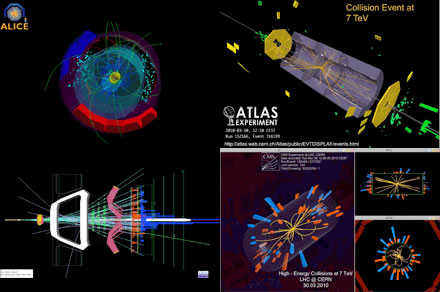Director's Corner
8 April 2010
 Barry Barish |
Celebrating first 7-TeV collisions at the LHC
This past week marked the beginning of a new era for particle physics with the much publicised achievement of establishing the first 7-TeV collisions at the CERN Large Hadron Collider (LHC). Both the impressive performance of the accelerator and the fact that the detectors are in an advanced state of readiness bode very well for the early physics research programme. We should soon begin to have a glimpse of Terascale physics from searches for the origin of mass to looking for evidence of a new symmetry in nature that could even explain the dark matter. Even more intriguing is the real possibility for totally unexpected surprises that are awaiting us. We are looking to LHC science to establish what kind of lepton collider will be needed to best exploit the energy frontier in the longer term.
 All four LHC experiments saw collisions on 30 March, when 3.5-TeV beams collided for the first time. Image: CERN All four LHC experiments saw collisions on 30 March, when 3.5-TeV beams collided for the first time. Image: CERN |
Along with many of my colleagues, I have been anticipating this day for more than two decades. It is especially rewarding to finally open the central frontier of particle physics after the very frustrating and disappointing cancelation of the Superconducting Super Collider (SSC) in 1993. At that time, I was co-spokesman, with Bill Willis, of one of the two large detectors (GEM) planned for the SSC. We had reached an advanced state of R&D and detector design for GEM when the SSC project was cancelled. It has been gratifying for me to see some of the GEM technical developments could be employed in LHC detectors, and now it is even more pleasing that many of my GEM collaborators are an integral part of the experiments. They will now be able to reap the well-deserved harvest for their dedication and stick-to-it-iveness.
For particle physics the start-up of the LHC symbolises the full recovery of our field. There is no denying the damage that was done by the SSC cancellation, yet the field has thrived with great new discoveries (like neutrino oscillations), a plethora of important measurement in B-physics and the opening of exiting new frontiers (like particle astrophysics) in the interim. Now, we can also pursue the traditional quest our field, to study particle physics at higher and higher energies.
What should we anticipate from the physics programme at LHC? The present plan is to carry out an extended data-taking run (18 – 24 months) until 2012, at 7 TeV, obtaining one inverse femtobarn of integrated data. This is a modest start, compared to the ultimate potential of the LHC, but will provide enough data for the two large experiments, CMS and ATLAS, to extend the search for supersymmetry to double the present mass limits, with reasonable likelihood that some discoveries like light squarks and sleptons will be observed. I recommend this week's feature if you'd like to know more about the physics potential of the LHC at 7 TeV.
The physics from the LHC will emerge over some period of time. The first data run will be followed by an extended shutdown to prepare for running at higher energy and luminosity. In order to establish the physics case for the ILC and to validate and optimise the ILC machine and detector parameters, we will need to keep a close eye on LHC results as they are produced.
In closing, I would like to add my hearty congratulations to all of those who have worked so hard to make the CERN LHC a reality, including the more than 10,000 experimenters from over 80 countries who will now be able to pursue their dreams of learning what lurks at the Terascale.
-- Barry Barish